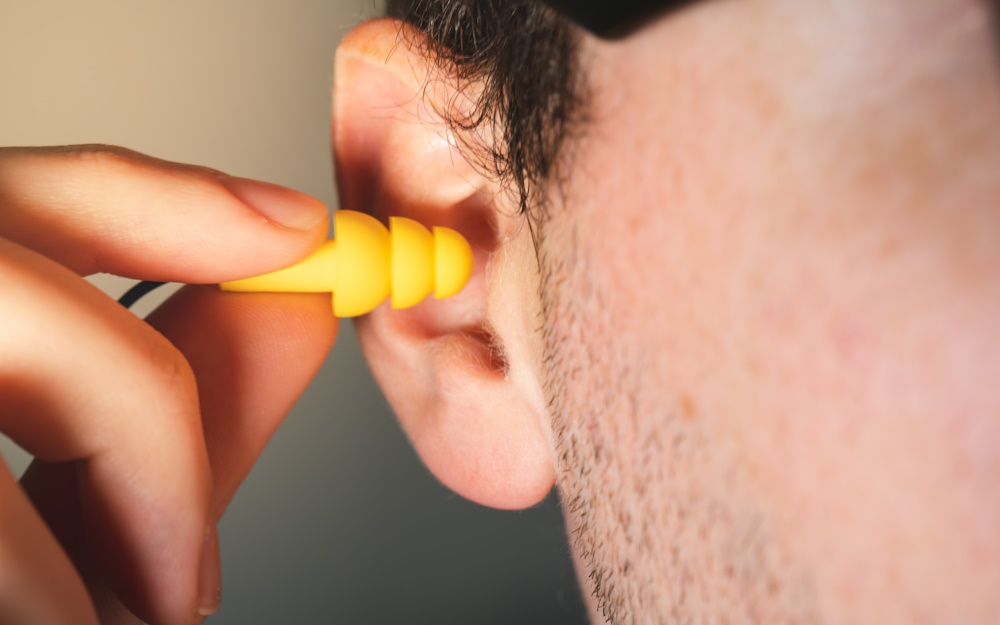It’s hard to visit any kind of store without seeing some kind of product created by the company 3M. One of their most well-known products is the wall hanger that you can use and then remove without damaging the wall. But that’s just one of many products that 3M backs. One of their lesser-known products is a set of earplugs made by one of their subsidiary companies called Aearo Technologies Inc. Unfortunately, the earplugs are not as well-loved as the wall hangers, and in 2016 a lawsuit was filed against 3M claiming that the earplugs were defective, resulting in hearing loss for many veterans who relied on the earplugs to protect their hearing. Only recently has the lawsuit come to a settlement that numbers in the billions and is now considered one of the largest mass tort cases in the United States.
From 2003-2016, thousands of military service members suffered hearing loss or other disabilities due to these defective earplugs, leading to the highest rate of hearing loss among veterans ever. Those thousands of individuals will now be able to receive compensation from the 3M company responsible for the faulty design, faked test results, and mislabeling of the military earplugs.
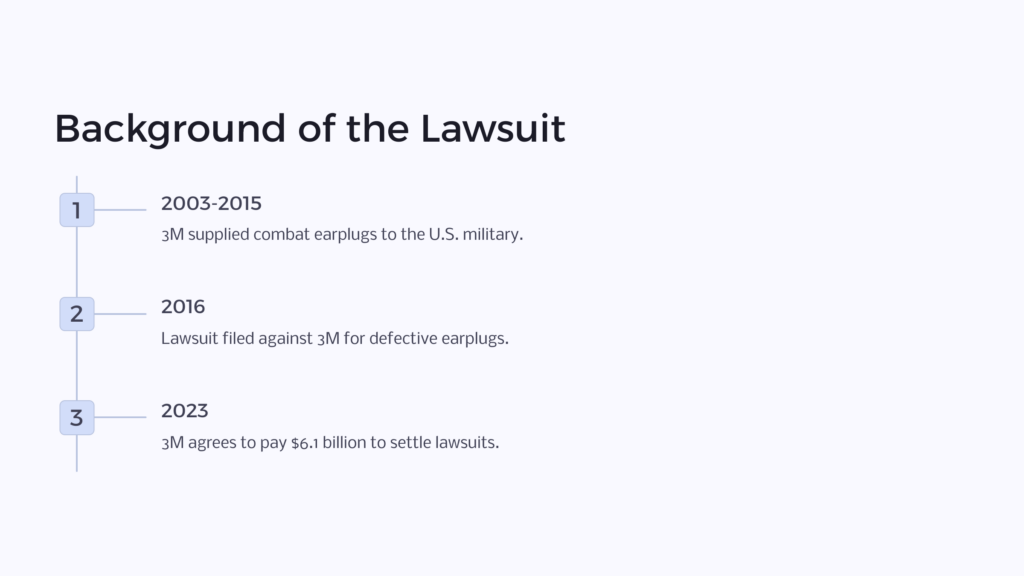
If you think you might have been affected by this lawsuit, or are wondering if you are eligible for compensation for hearing damage, we have everything you need to know about the 3M earplug lawsuit as well as its implications and possible compensation payouts. This article also contains resources and guidance for those wanting to pursue a claim against 3M.
What is the 3M Earplug Lawsuit?
Between 2003 and 2015, the 3M company manufactured and supplied the United States military with combat earplugs to protect military members from any loud sounds associated with combat and training. Service members are regularly exposed to dangerously high decibels while during combat and training, and are issued earplugs to protect their hearing. These earplugs were the standard issue for soldiers in Afghanistan and Iraq. In 2016, Moldex-Metric Inc. filed a lawsuit against 3M for knowingly selling defective earplugs that did not meet the protective standard required by the government. The lawsuit claimed the earplugs were responsible for hearing loss and damage, such as tinnitus, for thousands of soldiers for more than a decade.
3M has argued that the earplugs are not defective by design, and only fail to work when used improperly. They collaborated with the US Military to make the design and implement the requested features. 3M has tried unsuccessfully to use the government-contractor defense to absolve the company from liability. However, there was never a written contract regarding the design of the earplugs, which means that that particular defense was denied.
In 2018, 3M agreed to pay $9.1 million to the Department of Justice, which allowed them to resolve the lawsuit without admitting liability. Since then, individual military members have been suing 3M, alleging the defective earplugs caused them hearing loss. In 2022, 3M’s subsidiary company that made the earplugs, Aearo Technologies Inc., filed for bankruptcy protection. However, their request was denied and 3M, as the parent company, was ordered by the judge to participate in settlement negotiations. On August 29, 2023, 3M agreed to pay $6.1 billion to settle the lawsuits.
Understanding the 3M Earplug Design Flaw
The 3M military earplug lawsuit is a claim of product liability. With such claims, the product must be proven to be defective in either design, manufacturing, or labeling (instructions, warning labels, etc.). It was alleged that the 3M Combat Arms earplugs were defective in design and labeling.
Up until 2003, military service members carried multiple sets of earplugs that had different purposes. They needed total ear protection from repetitive loud noises, as well as earplugs that would protect their hearing while allowing them to communicate with each other. 3M and Aearo Technologies Inc. believed they could find a solution to combine the needs into a single product.
The Combat Arms Earplugs were yellow and green dual-ended earplugs that were designed to block general noise on one side and block specific kinds of noises encountered within training and combat on the other. They were marketed to the government as a low-cost solution to the rising hearing loss problems within the military. However, the earplugs were designed with a stem that was too short and a flange that was too stiff, resulting in an incomplete seal within the ear without the wearer’s knowledge. In demonstrations, the design flaw was concealed by the manufacturers by pushing back the flange on the unused end of the earplug while the other end was inserted into the ear. The manufacturers then failed to provide instructions to soldiers about how to properly use the earplugs to compensate for the flawed design.
3M claimed the yellow side of the earplugs offered a 0-decibel rating, a military requirement. This would allow service members to hear verbal commands while blocking out intermittent loud noises, such as explosions. Because of the ill-fitting earplug, when tested, the yellow end resulted in a -2, which meant amplification instead of deafening. This caused ear damage instead of protection.
The green side of the earplug was designed to reduce the sound of constant, high-decibel sounds, such as gunfire during combat. The manufacturers allegedly falsified the earplug’s decibel ratings to indicate that all sound would be blocked when wearing the green side of the earplugs. Unfortunately, that was not the case.
Not only was the design faulty, but the hearing devices should have been tested by the American National Standard Institute which implements a noise reduction rating to provide better ear protection for veterans. However, 3M used its own laboratories and testing procedures instead, which is considered highly inappropriate. They also failed to properly label their earplugs with proper instructions or provide warnings to users about the faulty design.
Who May Have Been Affected?
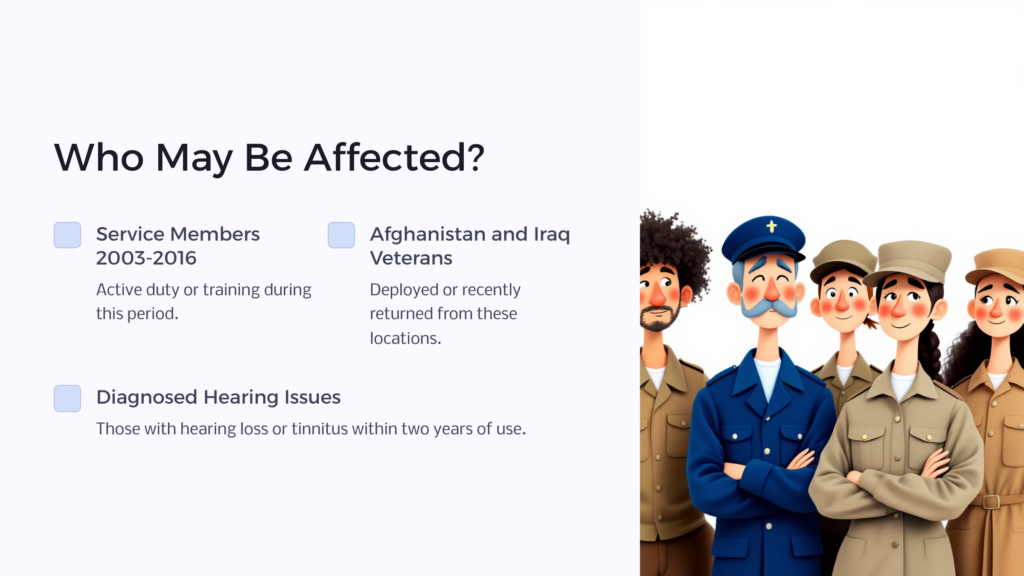
The defective earplugs affected thousands of service members between 2003 and 2016. The earplugs were a standard issue to any service members on active duty or training. Any personnel serving in Afghanistan or Iraq at this time, or who recently returned from deployment, have likely been affected. These devices have been proven ineffective at protecting hearing, and have led to hearing loss and tinnitus.
Qualifying for Compensation: Who is Eligible?
If you were a service member between 2003 and 2016, you may be eligible for compensation from the lawsuit. 3M Combat Arms earplugs were the standard issue to military service members at that time. The lawsuits recognize both noise-induced hearing loss and delayed hearing loss issues, such as tinnitus. If you are a veteran who was on active duty between 2003 and 20016, and if you’ve received any hearing-related diagnosis or medical treatment within two years of wearing the 3M Combat Arms earplugs, you may have eligibility for the 3M lawsuit. (You must have been honorably discharged to receive legal aid from Veteran Affairs.)
Steps to Take in Filing a 3M Earplug Claim
If you intend to file a 3M earplug claim to receive defective earplug compensation, there are some steps you must take. First, you’ll need to have medical records that establish you have suffered an injury due to the use of these defective earplugs. These injuries can include hearing loss, tinnitus, or loss of balance. These records can be diagnoses or records of medical visits and bills, including any hearing-correction devices or surgeries. You’ll also need to provide your DD214, your official service record, and your Veterans Administration Record to the court. If your disability claim is denied, you may choose to appeal the decision with the help of a lawyer. It is common for disability claims to be appealed several times before they are accepted.
Second, you’ll need to find a lawyer or law agency that is accepting military earplugs hearing loss claims. You may be able to file an individual lawsuit or join a comprehensive class action lawsuit that represents several military members at once. Because of the large number of lawsuits being filed, there are certain agencies specifically representing those affected by the defective earplugs. You can also contact your veteran disability attorneys to receive legal advice and guidance.
Calculating Compensation: What Factors Are Considered?
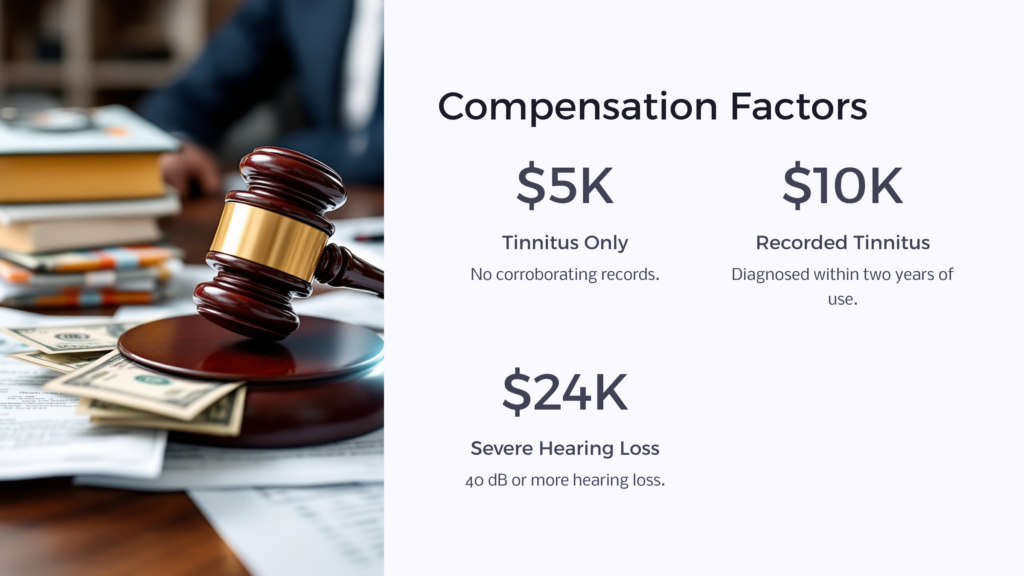
If you are a claimant, then you can expect to receive a monetary payout as compensation. The payout will depend on the settlement amount, the severity of your injuries, and the proven damages you incurred. This amount may vary depending on individual cases, so it’s impossible to state the exact payout you can expect to receive.
The settlement is being issued to claimants through a point system. However, as of October 2, 2023, that point system has not been publicized. Fortunately, there is some information regarding expedited payouts to claimants in 2024. Here is a brief guide:
- Tinnitus only: $5,000. This payout is for claimants who have tinnitus with no records to corroborate or confirm their injuries.
- Recorded Tinnitus: $10,000. This payout is for claimants with diagnosed tinnitus who have sought medical attention within two years of using the earplugs.
- Slight Hearing Loss: $10,000. This payout is for claimants with at least 15 dB hearing loss.
- Mild Hearing Loss: $16,000. This payout is for claimants with at least 20 dB but less than 35 dB hearing loss.
- Moderate to Severe Hearing Loss: $24,000. This payout is for claimants with 40 dB or more hearing loss.
This is just a rough estimate of the possible expedited payouts for claimants impacted by the 3M Combat Arms earplugs. It’s worth noting that if you are eligible for more than one category, you will receive the higher amount of the two, not a combined amount. This was the only information we could find, but more information about possible compensation may be published at a later date.
The compensation is scheduled to be delivered in October for the next few years. Expedited payments can be expected by the end of 2024. You may find more information about the payment schedule here.
Legal Representation: Do You Need a Lawyer?
The legal world is complicated to navigate, but you may wonder if it might be worth the expense to hire a lawyer to file a disability claim. For more information, we’ll refer specifically to a veteran disability attorney.
Veteran disability attorneys can explain the application process and the types of benefits that are available to veterans. They can review your case to determine if you’re eligible for benefits, collect medical documentation to support your claim, help you file your application, and appeal a denial for disability benefits. In this case, they could provide legal assistance for 3M lawsuit filings.
Applying for benefits can be a difficult process and many veterans find that hiring a disability attorney, specifically a veteran disability attorney, provides them with legal advice, support, and guidance.
Many disability attorneys accept veteran disability cases on a contingency fee basis, which means they only get paid if the veteran receives their benefits. They would then receive a one-time percentage of the benefits the veteran received. Lawyers can only charge you for the appeal of the claim, not for the initial application.
When hiring a lawyer, be sure to carefully read the retainment agreement to make sure you won’t owe them any money if they fail to recover back pay for your claim. Also be aware of extra expenses, such as expert witnesses or doctor’s reports.
While it is possible to file a claim yourself, it is often helpful to have a lawyer to help you collect all the documentation and submit it correctly. They are especially helpful if your case is vague or lacking proof. If your claim is denied for any reason, you can appeal the decision to have the court reconsider your case. You will need a lawyer to appeal the decision for disability.
Is The 3M Earplug Lawsuit a Class Action?
A class action lawsuit is one lawsuit filed on behalf of a group of people who have all suffered the same injury. They are typically handled by a single law firm with the settlement being split equally between the plaintiffs regardless of their circumstances or injuries.
The 3M earplug lawsuit began as individual lawsuits because the plaintiffs didn’t all claim the same injury. Once the federal court system became aware of the many lawsuits, they ordered the lawsuits to be condensed under a single federal judge, encompassing all hearing-loss-related lawsuits due to the defective 3M Combat Arms earplugs.
Scams at the 3M Earplug Lawsuit
Since the $6.1 billion settlement announcement, there has been a rise in scams against claimants. Scammers and fraudulent actors are impersonating employees of Archer Systems LLC, the company in charge of administering the settlement. They have been cold-calling claimants to obtain personal and sensitive information, such as social security numbers, dates of birth, or addresses. Several claimants of the defective earplugs have also been victims of identity theft through those means. Judge M. Casey Rodgers has issued an order warning claimants to be vigilant and to safeguard their sensitive information from scammers.
Potential Long-Term Health Effects of 3M Earplug Use
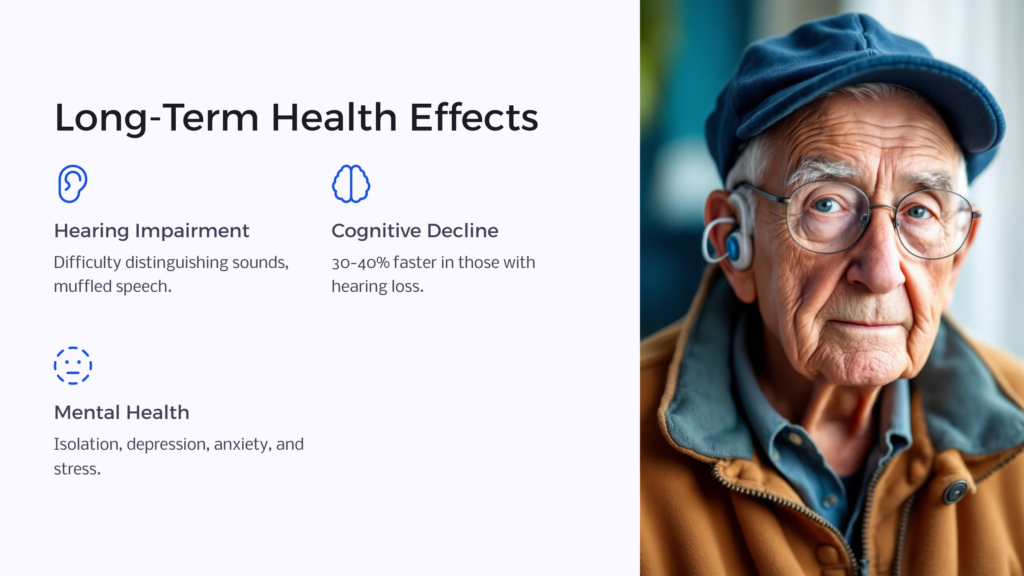
According to the US Department of Veteran Affairs in Virginia, hearing loss is one of the top service-related disabilities for American veterans. As of 2020, over two million veterans are receiving some kind of compensation for hearing loss and tinnitus. Hearing loss covers both complete and partial hearing loss and tinnitus, which is a long-term ringing or similar noises in the ear. Both hearing loss and tinnitus can affect the quality of life and lead to depression, irritability, fatigue, attention issues, anxiety, insomnia, cognitive impairment, chronic stress, and, in serious cases, suicidal tendencies. Damage to the inner ear can also lead to loss of balance.
Hearing loss caused by 3M earplug use is the same as hearing loss from any other noise-induced hearing loss. Repetitive exposure to loud noises, such as aircraft, machinery, or gunfire contributes to hearing loss. However, the symptoms go beyond just difficulty hearing. The long-term effects of earplug use and subsequent hearing loss can include difficulty hearing, muffled consonants, muffled speech, or difficulty distinguishing individual sounds in noisy environments.
Since your sense of hearing connects you to the world, a loss of hearing can profoundly affect your connection to those around you. If you cannot participate in a conversation or understand what someone is saying, you lose valuable opportunities to connect with other human beings. It is common for hearing-impaired people to withdraw from conversation completely. This leads to isolation, which can cause depression.
Hearing loss can also cause cognitive impairment and decline. John Hopkins studied hearing loss in older test subjects which showed cognitive decline was 30-40% faster in those with hearing loss. Cognitive impairment is also heightened by those in isolation with depression, so the cognitive impairment can be compounded in those with hearing loss.
3M Earplug Lawsuit Updates
There have been several updates regarding the 3M earplug lawsuits and settlements. In August 2023, the 3M board of directors officially approved the $6.1 billion settlement which will be paid out in the coming years. On September 18th, 2023, there were 242,604 pending cases in the 3M earplug MDL. As of October 10, 2023, 3M has withdrawn several appeals regarding the combat earplugs. The judge has warned lawyers against filing redundant filings or claims, which can drain court resources. The Judge ordered individual claimants to provide the Settlement Data Administrator with their information or their cases will be dismissed. Thirty-nine plaintiffs have already had their cases dismissed due to the breach of the court’s directions.
VA Benefits for Hearing Loss
Veterans with hearing loss can apply for more than just financial compensation. The VA offers several VA benefits for hearing impairment. Veterans may be able to receive free hearing aids and assisted listening devices, which allow for the flow of sound and enhance communication. Veterans may also have access to vocational rehabilitation services, which include specialized training, skill development, and career counseling. These services are designed to rehabilitate veterans and help them reach their career goals after military service. The VA also offers independence and community participation, which helps and encourages veterans to maintain their independence and re-enter society. The goal is to help veterans regain their quality of life that may have been influenced by active service for them to lead normal, happy lives.
Resources for Support and Assistance
If you believe you have been affected by the 3M veteran earplug lawsuit, you should consider pursuing legal action to receive compensation. There are a variety of resources and organizations that offer support and assistance. Veterans Disability or Veteran Affairs is a great place to start, as well as finding local community organizations for veterans or disabled members of society. If you are interested in pursuing legal action or finding out what benefits you qualify for, you should visit Benefits.com. Benefits.com offers veteran disability services to help you get the benefits you need, including social security disability benefits, SSI benefits, food stamps, Medicaid, Medicare, unemployment, VA loans, and retirement. They offer legal services as well as advice and guidance while applying for benefits.
 Benefits.com Advisors
Benefits.com Advisors
With expertise spanning local, state, and federal benefit programs, our team is dedicated to guiding individuals towards the perfect program tailored to their unique circumstances.
Rise to the top with Peak Benefits!
Join our Peak Benefits Newsletter for the latest news, resources, and offers on all things government benefits.















